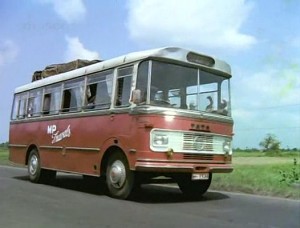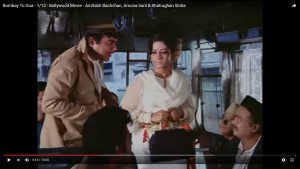Released in 1972, the Hindi movie ‘Bombay to Goa’ is about adventure as much as it is about comedy. Believed to be a remake of 1966 Tamil Nadu movie, Madras to Pondicherry, “Bombay to Goa’ epitomises a road journey to an exotic location that throws many surprises and revelations at the viewers, glueing them to their seats in a bout of laughter and anxiety. The movie begins with the tourists boarding a seemingly customised Tata LP 1210 bus at Bombay (now Mumbai). One of them is a young lady ‘Mala, played by Aruna Irani. She boards the bus as it is about to leave for Goa. Facing stiff opposition from home, Mala has fled from home, and stealing cash in the process. Influenced by Sharma (played by Manmohan) and Verma.(played by Shatrughan Sinha), to who she hands over the stolen cash in return for finding work in the film industry, Mala is on the run. Sharma has been murdered and Mala has witnessed it. Fearing Verma will eliminate her, she is running for her dear life. Mala finds a protector in young Ravi (played by Amitabh Bachchan). Ravi falls for Mala as the journey progresses. Apart from Mala and Ravi, there is an assortment of some very interesting characters that make the travelling crowd on the bus. Equally interesting are the driver of the bus, Anwar Ali, and the conductor, played by comedian Mehmood. The LP 1210 is witness to fun, excitement and moments of trepidation that roll one after the other in quick succession. The movie ends with all the travellers on the bus uniting to overpower Verma and his crooks, and handing them over to the cops.
Painted in an attractive shade of red and white, the LP 1210 looks modern and classy for its time. The interiors look comfortable and a cut above the market. The pleated curtains, the comfortable seats, the hat racks, all add to the ambience; help create the right atmosphere. A forward control design, the LP 1210 went on to be a popular choice for various types of bus operators after it was launched in the late 50s. It shared the chassis and engine with the L1210 truck, and also the assembly line at Telco’s Jamshedpur plant. The OM312 4580 cc four-cylinder diesel engine produced 110 bhp of power. It was mated to a five-speed manual transmission. Brakes were service hydraulic assisted by a single chamber air pressure booster. Steering was recirculating ball type. Suspension was made up of semi-elliptic silico-manganese leaf springs with hydraulic shock absorbers.





















